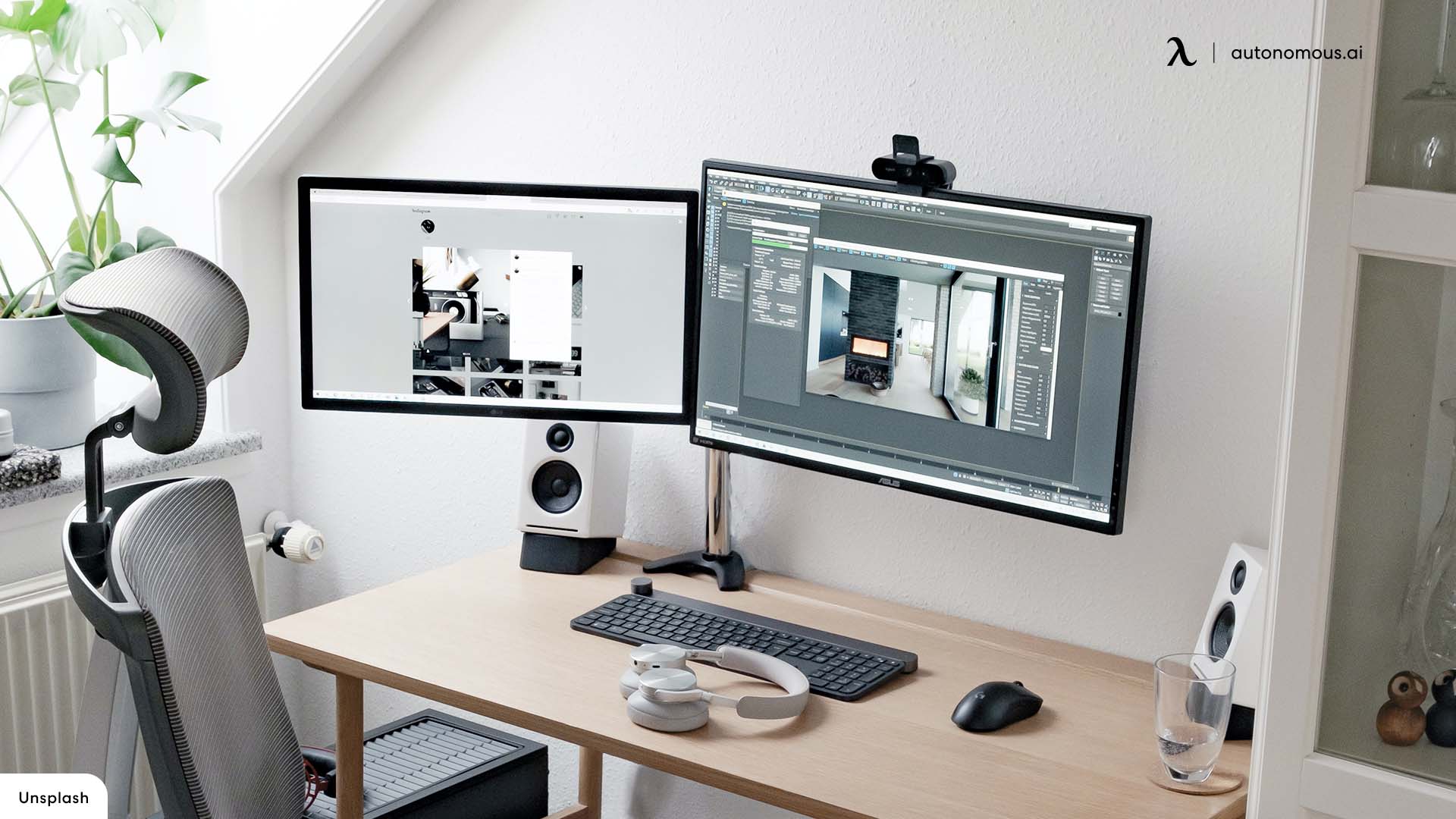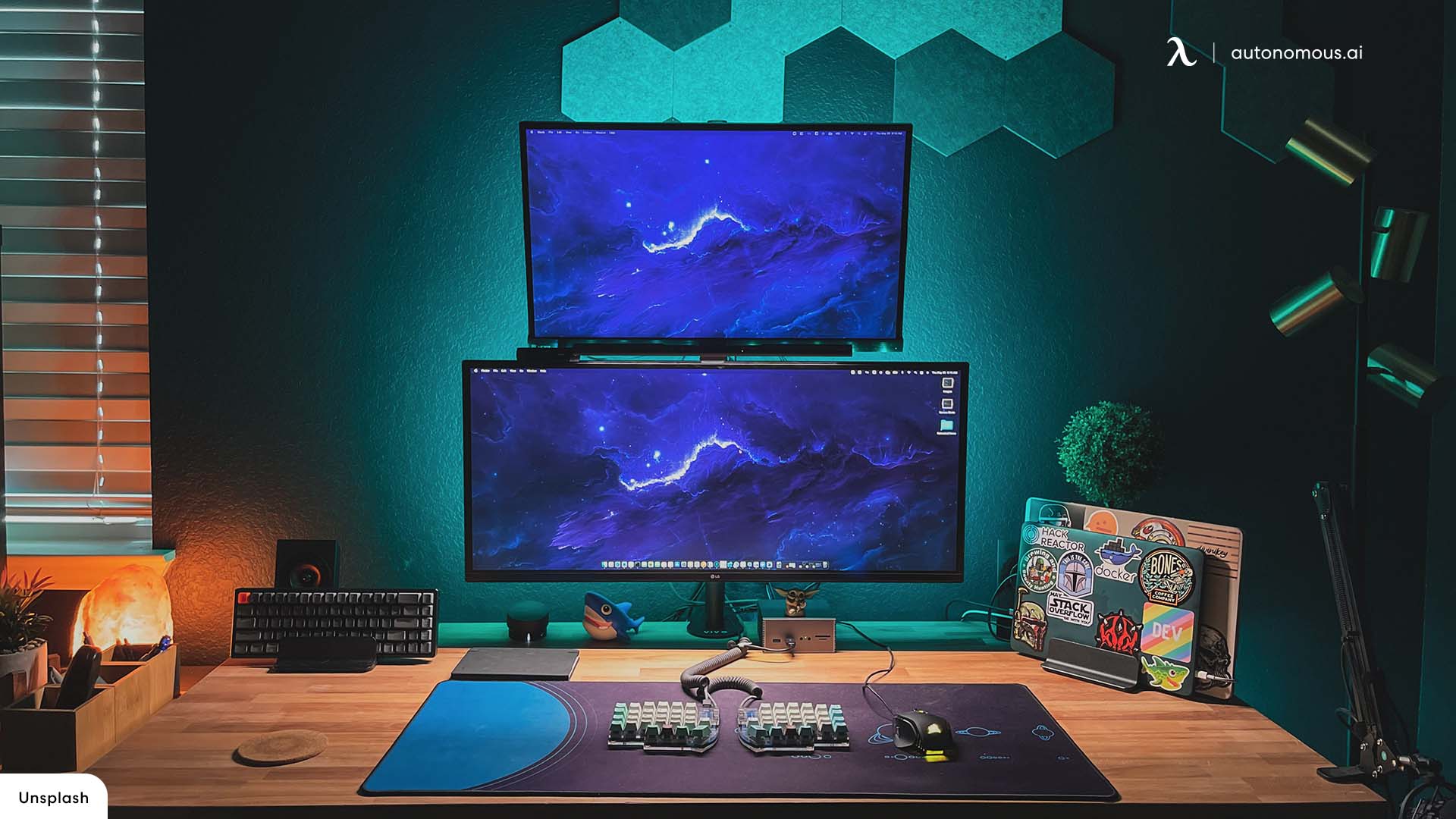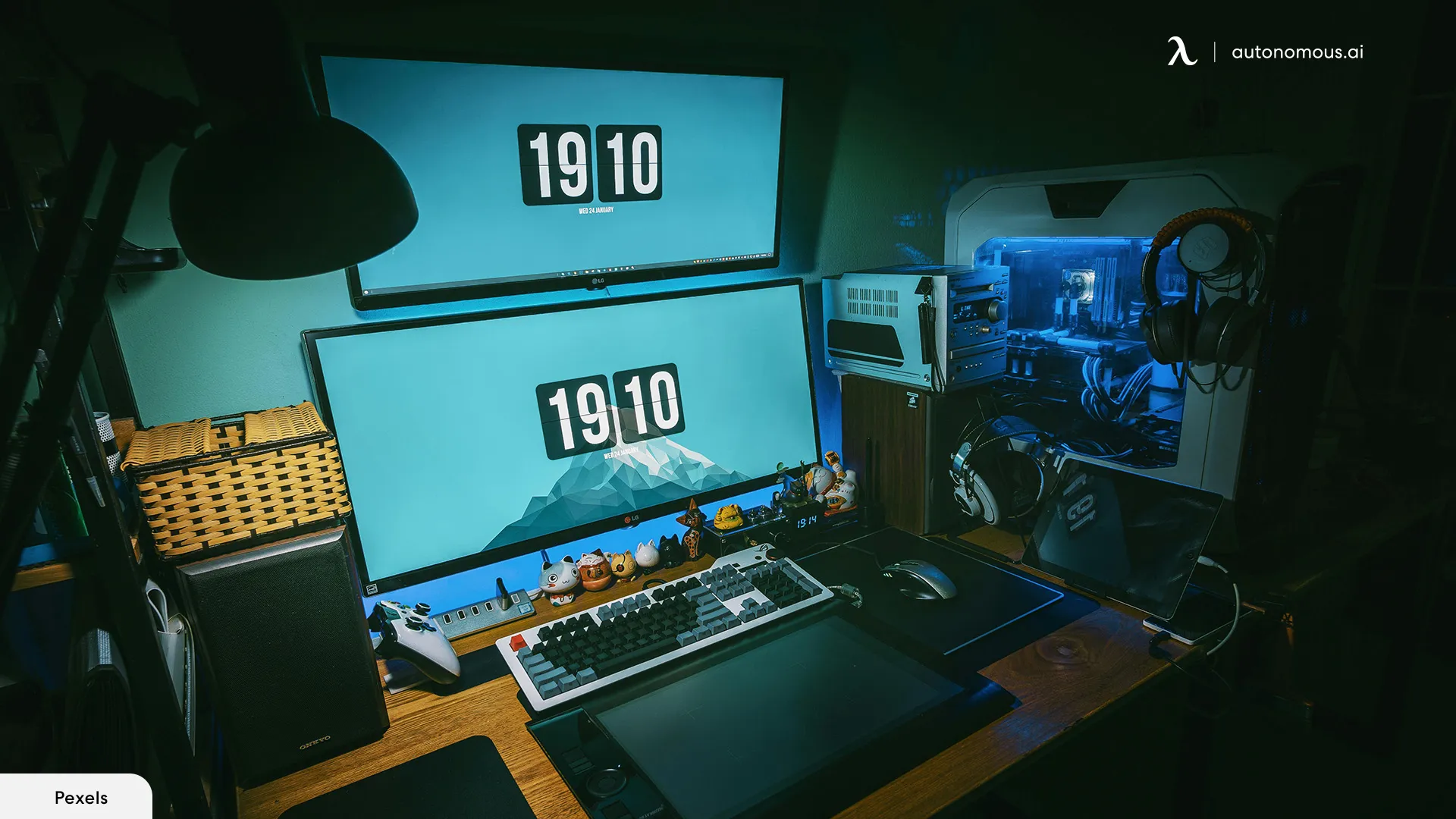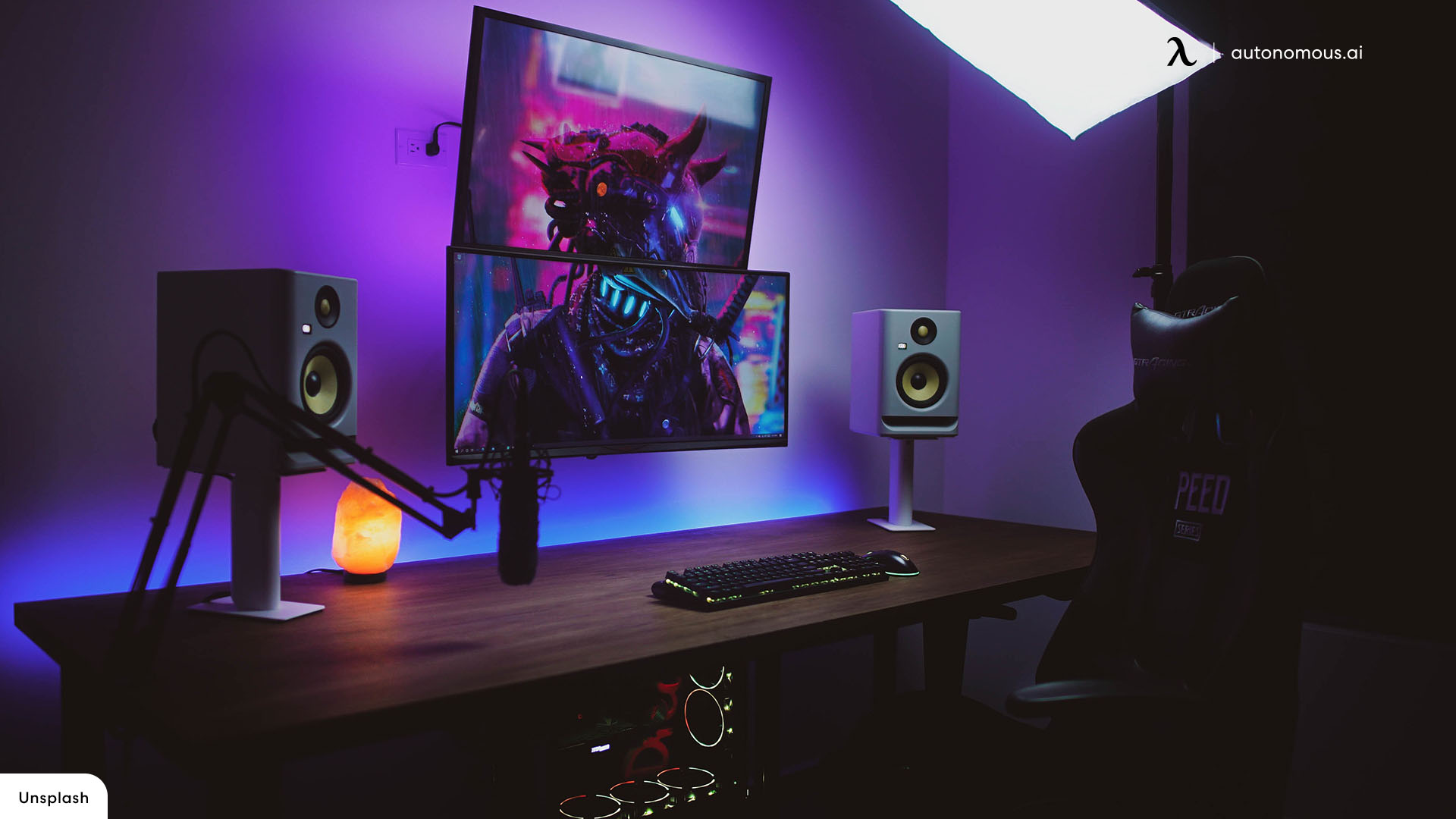
24-Inch vs. 27-Inch Monitor: Which Should You Choose?
Table of Contents
Choosing the right monitor size can significantly impact your productivity and gaming experience. The 24-inch and 27-inch monitors are among the most popular choices, each offering distinct advantages and potential drawbacks. This comprehensive guide will help you understand the key differences between 24-inch vs. 27-inch monitors, allowing you to make an informed decision based on your specific needs.
Quick Comparison: 24-Inch vs. 27-Inch Monitors
| Feature | 24-Inch Monitor | 27-Inch Monitor |
|---|---|---|
| Resolution | Full HD (1920x1080) | QHD (2560x1440), 4K (3840x2160) |
| Pixel Density | Higher with Full HD | Lower with same resolution |
| Desk Space | More compact | Requires more space |
| Field of View | Smaller, less immersive | Larger, more immersive |
| Price | Generally more affordable | Typically more expensive |
| Gaming Experience | Suitable for competitive gaming | Better for immersive gaming |
| Productivity | Adequate for basic tasks | Better for multitasking |
| Comfort | Easier on the eyes for close use | Better for multitasking with multiple windows |

24-Inch vs. 27-Inch Monitor for Work
24-Inch Monitor for Work
A 24-inch monitor is an excellent choice for users with limited desk space or those who primarily engage in tasks that do not require extensive screen real estate. Here are some key considerations:
- Desk Space: A 24-inch monitor occupies less desk space, making it ideal for smaller workstations or cluttered environments. For more space-saving options, consider using a monitor arm to free up desk space.
- Pixel Density: With a Full HD (1920x1080) resolution, a 24-inch monitor offers a higher pixel density compared to a larger monitor with the same resolution. This results in sharper text and images, which can be beneficial for tasks like document editing and web browsing.
- Affordability: Generally, 24-inch monitors are more affordable than their 27-inch counterparts. This makes them a cost-effective option for budget-conscious users.
However, the smaller screen size may limit multitasking capabilities, as there is less space to display multiple windows side by side.
>>> Is 24 Inches a Good Size for a Monitor?
27-Inch Monitor for Work
A 27-inch monitor provides a larger screen area, which can enhance productivity, especially for tasks that benefit from a broader view.
- Multitasking: The increased screen size of a 27-inch monitor allows for better multitasking, as users can easily display multiple windows simultaneously. This is particularly useful for tasks such as programming, graphic design, and data analysis.
- Higher Resolution Options: Many 27-inch monitors offer higher resolutions such as QHD (2560x1440) or 4K (3840x2160), providing more screen real estate and sharper images. This can be advantageous for detailed work like video editing and CAD applications.
- Comfort: The larger screen size can reduce eye strain, as it allows for more comfortable viewing distances and better ergonomics. A dual monitor stand can further enhance the ergonomic setup by positioning the monitors at the optimal height and angle.
However, 27-inch monitors require more desk space and are generally more expensive. They may also have a lower pixel density at the same resolution compared to 24-inch monitors, potentially resulting in less sharp images.

24-Inch vs. 27-Inch Monitor for Gaming
24-Inch Monitor for Gaming
A 24-inch monitor can be an excellent choice for gamers, particularly those who play competitive or fast-paced games.
- Competitive Gaming: The smaller screen size allows for quicker eye movement across the screen, which can be advantageous in competitive gaming scenarios where reaction time is critical.
- Higher Frame Rates: Many 24-inch monitors with Full HD resolution support higher frame rates and faster response times, which can enhance the gaming experience by providing smoother visuals and reducing motion blur.
- Affordability: Generally more affordable, 24-inch monitors are a budget-friendly option for gamers looking to invest in high-performance gaming setups without breaking the bank.
However, the smaller screen size may not provide the same level of immersion as a larger monitor, which can be a drawback for gamers who prefer expansive, visually-rich games.
27-Inch Monitor for Gaming
A 27-inch monitor offers a more immersive gaming experience, particularly for games with rich graphics and detailed environments.
- Immersive Experience: The larger screen size enhances immersion, making games feel more engaging and visually impressive. This is particularly beneficial for genres like RPGs, open-world games, and simulators.
- Higher Resolution Options: Many 27-inch monitors support resolutions such as QHD or 4K, providing sharper images and more detailed visuals. This can enhance the overall gaming experience by bringing out finer details in the game.
- Field of View: The increased screen size can provide a broader field of view, which can be advantageous in certain games, allowing players to see more of the game world at once.
However, 27-inch monitors can be more expensive and may require more powerful hardware to run games at higher resolutions and frame rates. Additionally, the larger screen size might necessitate a larger desk space and a more ergonomic desk setup to avoid neck and eye strain.

FAQs
How big is a 24-inch monitor?
A 24-inch monitor typically measures about 21 inches wide and 12 inches tall, depending on the bezel and aspect ratio. It’s compact enough for smaller desks while still offering a comfortable viewing experience for basic tasks and casual gaming.
How big is a 27-inch monitor?
A 27-inch monitor is roughly 24 inches wide and 14 inches tall. It provides more screen real estate, making it ideal for multitasking, creative work, and immersive gaming setups.
Is a 27-inch monitor good for gaming?
Yes, especially for immersive and high-resolution gaming. A 27-inch monitor with QHD or 4K resolution offers a broader field of view and richer visuals—perfect for RPGs, open-world games, and simulators.
Is a 24-inch monitor good for gaming?
Definitely. A 24-inch monitor is often preferred for competitive gaming like FPS titles due to its tighter field of view and faster eye tracking. It's also more affordable and easier on system performance at 1080p.
How long is a 24-inch monitor?
Measured horizontally, a 24-inch monitor is approximately 21–22 inches long, depending on the bezel size and design.
How long is a 27-inch monitor?
A 27-inch monitor typically measures about 24–25 inches in length, depending on bezel and frame style.
How wide is a 27-inch monitor?
A 27-inch monitor is usually about 24 to 25 inches wide, depending on the bezel and frame design. Most use a 16:9 aspect ratio, which gives them that width, making them ideal for multitasking or immersive viewing—just make sure your desk can accommodate it comfortably.
How wide is a 24-inch monitor?
A 24-inch monitor generally has a width of about 21 to 22 inches. It fits comfortably on most desks and is suitable for single or dual monitor setups.
How tall is a 24-inch monitor?
A 24-inch monitor is usually about 12 to 13 inches tall without the stand. With the stand, height may increase by 3 to 6 inches depending on adjustability.
Is 1080p better on a 24-inch or 27-inch monitor?
1080p resolution looks sharper on a 24-inch monitor due to its higher pixel density. On a 27-inch screen, the same resolution is stretched across a larger display, which can make text and images appear slightly less crisp. If you're sticking with 1080p, a 24-inch monitor is the better choice for clarity. For a 27-inch screen, upgrading to 1440p (QHD) or 4K is recommended for optimal sharpness.
Dell 24 vs 27 inch monitor — which is better?
Dell’s 24-inch monitors are compact, sharp at 1080p, and ideal for everyday office tasks or small desks. In contrast, their 27-inch monitors offer more screen space, often support higher resolutions like QHD or 4K, and are better suited for multitasking, design work, or immersive use. If you want affordability and clarity, go with the 24-inch. If you prefer more workspace and upgraded visuals, the 27-inch is the better pick.
Is it better to use 2 24-inch monitors or 1 27-inch monitor?
Two 24-inch monitors offer more screen space overall and are great for multitasking—ideal if you like having multiple windows open side by side. A single 27-inch monitor provides a cleaner setup and less neck movement, which can be more ergonomic for focused work. If you rely on multiple apps at once, dual 24-inch screens are better. But if you want simplicity and less desk clutter, one 27-inch monitor works well.
Which is better: 24-inch 1080p or 27-inch 1440p?
A 24-inch 1080p monitor offers sharp image quality due to high pixel density, making it great for reading, browsing, and basic work. A 27-inch 1440p (QHD) monitor gives you more screen space and crisper visuals—ideal for multitasking, gaming, or creative work. If you want more detail and room to work, 27-inch 1440p is the clear winner. For budget-friendly sharpness, stick with 24-inch 1080p.
Is a 24 or 27-inch monitor better for competitive gaming?
A 24-inch monitor is generally preferred for competitive gaming. Its smaller size keeps all the action within your peripheral vision, allowing quicker reaction times. Many esports pros use 24-inch 1080p displays for this reason. A 27-inch monitor can still work well—especially if it has a high refresh rate—but it may feel slightly slower for fast-paced FPS games due to the larger viewing area.
Should I get a 24 or 27-inch monitor for FPS gaming?
For FPS gaming, a 24-inch monitor is typically the better choice. It keeps your field of view tighter and your eye movements faster, which is ideal for tracking targets and reacting quickly. A 27-inch monitor can offer a more immersive experience, but at 1080p, it may look slightly less sharp and require more head movement—something competitive players try to avoid.
Is a 24 or 27-inch monitor better for League of Legends?
Both sizes work well, but it depends on how you play. A 24-inch monitor offers better focus and quicker eye movement—great for ranked and competitive play. A 27-inch monitor gives you a more immersive view of the map and spell effects, which can enhance the experience for casual or visual-oriented players. If you prioritize performance, go with 24-inch; for visuals and comfort, 27-inch is a solid pick.
Should I use a 24 or 27-inch monitor for photo editing?
A 27-inch monitor is the better choice for photo editing. It offers more screen space, higher resolution options like 1440p or 4K, and greater detail visibility—crucial for precise edits and color work. While a 24-inch 1080p monitor can handle basic edits, professionals and creatives will benefit more from the clarity and workspace of a 27-inch display.
Is a 24 or 27-inch monitor better for programming?
A 27-inch monitor is generally better for programming. It gives you more vertical and horizontal space to view longer lines of code, multiple files, or browser windows side by side. Paired with a higher resolution like 1440p, text stays sharp and readable. A 24-inch monitor can work if space is tight, but a 27-inch display helps reduce scrolling and boosts productivity.
Is a 24 or 27-inch monitor better for trading?
A 27-inch monitor is better for trading. The larger screen allows you to view more charts, indicators, and news feeds at once without constant tab switching. Higher resolution options like 1440p also make detailed visuals easier to interpret. If you're monitoring multiple assets, the extra space and clarity of a 27-inch display provide a major edge over a smaller 24-inch screen.
How much desk space do I need for a 24-inch monitor?
A 24-inch monitor typically requires less desk space, making it suitable for smaller desks or workspaces. The average width of a 24-inch monitor is around 22 inches, and the depth can range from 7 to 10 inches, depending on the stand.
How much desk space do I need for a 27-inch monitor?
A 27-inch monitor generally needs extra desk space due to its larger size. The average width of a 27-inch monitor is about 24 to 26 inches, and the depth can range from 8 to 12 inches, depending on the stand design.
How do I decide which monitor size is right for me?
Consider your desk space, viewing distance, and usage. If you have limited space and sit closer to the screen, a 24-inch monitor might be more comfortable. If you have more space and prefer a larger display for multitasking or immersive gaming, a 27-inch monitor could be better.
Can my computer handle a 27-inch monitor?
Most modern computers can handle both 24-inch and 27-inch monitors. However, if you opt for a 27-inch monitor with a higher resolution, ensure your graphics card supports it and can deliver smooth performance, especially for gaming or graphic-intensive tasks.
Is a 27-inch monitor too big for a small desk?
It depends on the dimensions of your desk and your personal preference. A 27-inch monitor can fit on most desks, but it may feel cramped if your desk is very small. Measure your desk space and consider how much room you need for other peripherals and accessories.
Does a larger monitor consume more power?
Typically, larger monitors consume slightly more power than smaller ones. However, the difference is usually minimal and depends more on the monitor's technology (LED, LCD, etc.) and its energy efficiency rating rather than just its size.
Can I use a 24-inch and a 27-inch monitor together in a dual-monitor setup?
Yes, you can use a 24 and 27 inch monitor side by side in a dual-monitor setup. This can offer the best of both worlds, with the larger screen providing ample space for multitasking and the smaller screen serving as an additional display for reference materials, chat windows, or secondary applications.

Conclusion
Choosing between a 24-inch and a 27-inch monitor depends on your specific needs and preferences for work and gaming. A 24-inch monitor is compact, more affordable, and suitable for competitive gaming and basic work tasks, while a 27-inch monitor offers a larger, more immersive experience with better multitasking capabilities and higher resolutions.
If you're considering larger screens for productivity, comparing a 32 vs. 34-inch monitor for work can help determine which size best suits your workflow.
Spread the word
.svg)







